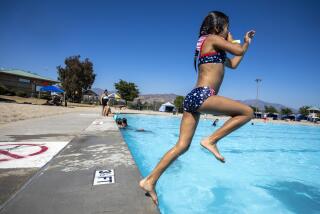Ways to Make Your Pool a Safe Haven
- Share via
Layers of Protection
* Fences and walls required by state law should be at least 5 feet high and should be installed completely around the pool. Use self-closing, self-latching gates with the latch placed out of a young child’s reach. Vertical bars in fencing should be no more than 4 inches apart. If a chain-link fence is used, the openings should be small enough so that a child can’t use them as a foothold for climbing.
* Ensure that items that could be used for climbing are not left near the fence.
* Consider adding a self-closing, self-latching mechanism to doors that open to the pool area.
* If your house forms one side of the barrier to the pool, doors leading from the house to the pool should be protected with alarms that produce a sound when the door is unexpectedly opened. Touch pads, which temporarily deactivate the alarm, should be installed out of the reach of children.
* Consider using a power safety cover--a motor-powered barrier that can be placed over the water area--when the pool is not in use. Some surface pool covers have been deemed unsafe by child-safety experts, so choose a cover that meets American Society for Testing and Materials safety standards.
* If you do install a pool alarm, use remote alarm receivers so the alarm can be heard inside the house or in other places away from the pool area.
* Install safety barriers even if you don’t have a small child, as others with children will probably visit your home.
*
Sources: U.S. Consumer Product Safety Commission, American Academy of Pediatrics, Children’s Hospital of Orange County
Keeping Kids Pool-Safe
In addition to creating several layers of protection, there are many ways to help keep children safe around the pool:
* Designate an adult “water watcher” to guard the pool area whenever children are present.
* Don’t leave toys nearby or floating in the pool when it’s not in use. They attract young children.
* If a child is missing, look in the pool first. Seconds count. Keep rescue equipment and a cordless phone by the pool, and post emergency numbers. Learn infant/child CPR and make sure others who care for your child know what to do in an emergency.
* Make sure all safety barriers are in good working order, and are used correctly. Instruct baby-sitters and visitors on their use.
* Constantly supervise infants and young children around water.
* Teach children never to swim alone or without adult supervision.
*
Sources: U.S. Consumer Product Safety Commission, American Academy of Pediatrics
Wristband Alarms
Another choice mentioned by the Consumer Product Safety Commission and the Good Housekeeping Institute is Safety Turtle, a band that locks around a child’s wrist ($186 for one wristband plus base; $60 for each additional wristband). It sounds an alarm within 2 seconds of touching water.
The alarm has its drawbacks. Caregivers must remember to put it on, and kids probably won’t wear the band consistently, so this shouldn’t be your only source of protection. Also, the wristband sounds an alarm when exposed to any water source, such as tap water, making it impractical at times. Call (800) 368-8121 or go to https://www.safetyturtle.com for more information.
For More Information
The Consumer Product Safety Commission offers three free pool-safety publications: “Safety Barrier Guidelines for Pools,” “How to Plan for the Unexpected” and “Guidelines for Entrapment Hazards: Making Pools and Spas Safer.” Copies can be downloaded at https://www.cpsc.org. Or write to Pool Safety, CPSC, Washington, D.C. 20207.
More to Read
Sign up for Essential California
The most important California stories and recommendations in your inbox every morning.
You may occasionally receive promotional content from the Los Angeles Times.













